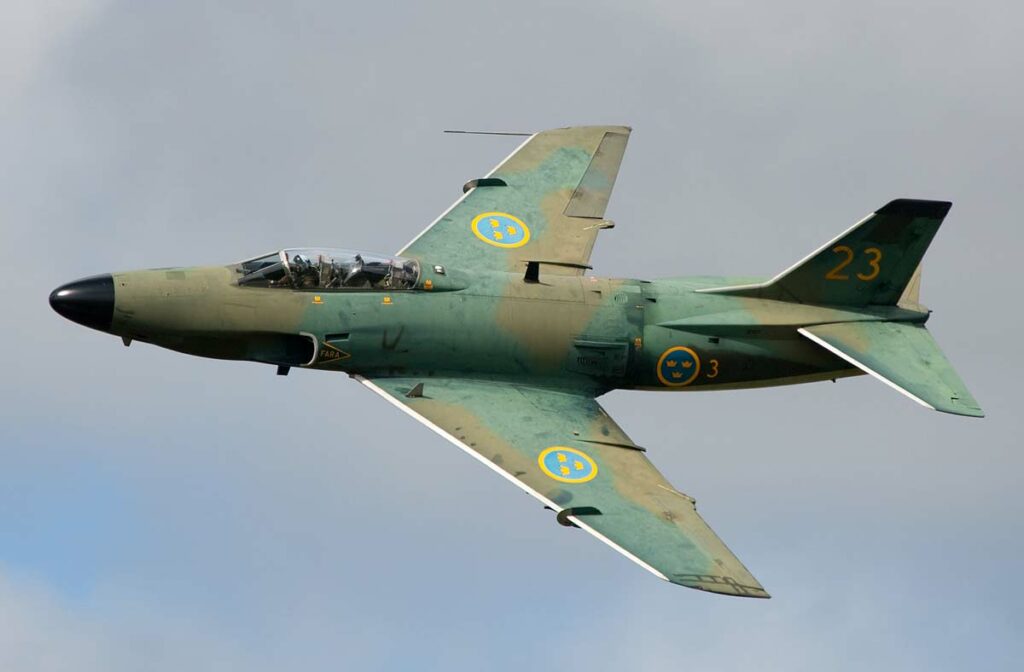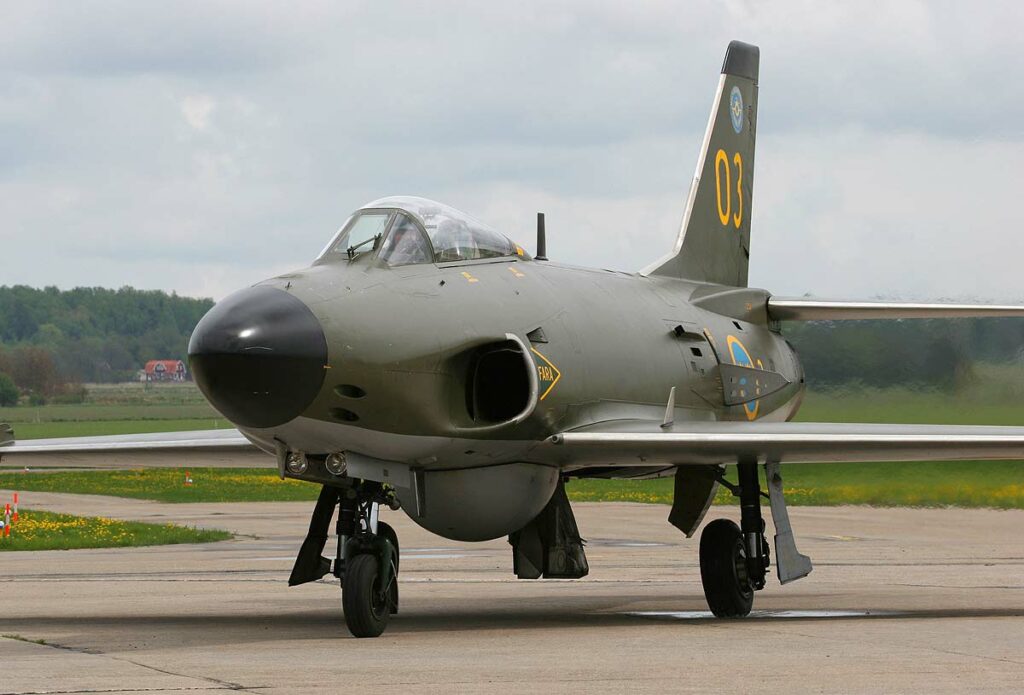The Saab J32 Lansen (Lance) is a Swedish two-seater transonic military aircraft developed for attack, fighter, and reconnaissance roles.
In brief
The Saab J32 Lansen, nicknamed “Lance,” was a Swedish transonic military aircraft designed for multiple roles, including attack, fighter, and reconnaissance. Developed by Saab in the 1950s, it was among the first aircraft to be specifically developed for attack missions. The Lansen had a streamlined design, with a 35° swept wing and advanced computer-aided aerodynamics. It was powered by a Rolls-Royce Avon turbojet engine and was armed with four 30 mm ADEN cannons or four 20 mm Bofors cannons, depending on the variant. Additionally, it could carry air-to-air and air-to-surface missiles, rockets, and assorted bombs. The Lansen was known for its ability to strike anywhere along Sweden’s coastline within an hour and for flying in all weather conditions.
The Saab J32 Lansen was a significant development in Swedish military aviation, playing a key role in the Cold War era.

History of Development
In the aftermath of World War II, Sweden aggressively pursued the development of jet combat aircraft. The need for a multi-role jet-powered aircraft to replace the aging fleet of propeller-driven aircraft became apparent. Saab, a Swedish aerospace and defense company, was tasked with developing an aircraft to meet these requirements.
The development of the Lansen commenced in late 1946 as a successor to the Saab B 18/S 18 attack aircraft. The initial contract for the design and mockup of Saab’s proposed P1150 design was issued in December 1948. The objective was to develop a jet-powered aircraft that could serve as Sweden’s standard attack aircraft, capable of operating in all weather conditions and striking targets along Sweden’s extensive coastline within one hour of takeoff.
The Lansen’s first flight took place in 1952, and it was officially commissioned into the Swedish Air Force in 1955. The aircraft was a groundbreaking design for its time, being one of the first to be developed using a mathematical coordinate system rather than traditional blueprints. This approach resulted in an aircraft with superior design and quality compared to other European designs of the era.
The Lansen’s development was indicative of the technological advancements and strategic needs of the Cold War period. It reflected Sweden’s commitment to maintaining a strong and independent defense capability, capable of protecting its extensive coastline and airspace.
Design
The Saab J32 Lansen featured a streamlined fuselage, one of the first aircraft to use computer technology to define the outer skin curvature and joints between skin panels to reduce drag. The wing had a 10 percent laminar profile and a 35° sweep, incorporating hydraulically-boosted ailerons and large Fowler flaps. The aircraft had a tricycle undercarriage with a single wheel on all landing gears.
The Lansen was designed to effectively accommodate electronic warfare systems and various weapons. The J 32 variant was armed with four 30 mm ADEN cannons, while the A 32 (“A” for attack) variant had four 20 mm Bofors m/49 cannons under flaps in the nose. The aircraft’s nose also contained Ericsson mapping and navigation radar in a blister fairing underneath the fuselage, which worked in conjunction with the Rb 04C anti-ship missile, one of the earliest cruise missiles in Western service.
The fuselage of the Lansen was relatively well streamlined, and the aircraft was powered by a single afterburning Svenska Flygmotor RM5 turbojet engine, a license-produced Rolls-Royce Avon RA.3/Mk.109. For maintenance access, the aircraft’s entire aft fuselage was detachable. The air intakes for the engine were located just forward and above the wing.
The Lansen had a straightforward general arrangement and was one of the first aircraft in the world specifically developed for attack missions. It could carry up to two RB04 missiles, one underneath each wing, and on the reconnaissance variant, up to six cameras could be installed in place of the four cannons.
Performance
The Saab J32 Lansen’s performance was characterized by its versatility and ability to operate in various roles effectively. The aircraft was powered by a Rolls-Royce Avon turbojet engine, which provided substantial thrust and enabled high-speed performance.
The Lansen had the capability to strike targets along Sweden’s 2,000 km coastline within one hour of takeoff and was designed to fly in all weather conditions, day and night. It was equipped with advanced electronic and weapons systems for its time, setting the standard for weapon systems design applied to later fighters.
The Lansen was armed with four cannons, bombs, rockets, air-to-air missiles, and Rb-04 long-range fire-and-forget air-to-surface missiles developed by Sweden, making it a formidable multi-purpose attacker. The J 32E variant specialized in electronic warfare/electronic countermeasure (ECM) roles, equipped with G-24 jamming systems and external jamming devices to disrupt enemy radars.
Variants of the Saab J32 Lansen
The Saab J32 Lansen had several variants, each tailored for specific operational roles:
- A 32A: The ground attack and maritime strike variant, armed with a quadruple battery of 20mm Bofors cannons in the nose. It had provisions for air-to-air and air-to-surface missiles or rocket pods.
- J32B: Originally a dedicated bad weather/night-fighter, later categorized as an “all-weather” mount. It was armed with 4 x 30mm ADEN cannons and provisions for infrared- or radar-guided missiles.
- S 32C: Designed for photographic reconnaissance sorties, based on the A 32A airframe but outfitted with camera equipment and an extended-range radar system.
- J 32D: Modified for the role of target tug, these pilotless aircraft served in aerial gunnery and missile tracking/engagement training.
- J 32E: A dedicated electronic warfare/electronic countermeasures variant, modified from J 32B models and equipped with a variety of specialized equipment for the role.
- J 32AD and J 32U: Proposed designs for improved performance and capabilities, but neither was selected for production.

Military use and combat of the Saab J32 Lansen
The Saab J32 Lansen served the Swedish Air Force in various capacities, including air-to-air combat, interception, ground attack, close-air support, and reconnaissance. The aircraft was used extensively by the Swedish Air Force, fielded across numerous squadrons.
The Lansen’s advanced design and capabilities made it a valuable asset in the Swedish military’s arsenal. It was used in various roles, from defending Sweden’s airspace to conducting maritime strikes and reconnaissance missions. The J 32E variant played a crucial role in electronic warfare, jamming enemy ground and airborne radars.
The Lansen’s armament capabilities, including cannons, missiles, and rockets, made it effective in both air-to-air and ground attack roles. Its versatility and advanced systems allowed it to remain relevant and effective throughout its service life.
The Saab J32 Lansen was exclusively operated by Sweden and was not sold to other countries. It remained in service until 1997, when it was finally retired. The aircraft was replaced by more modern aircraft like the Saab JAS 39 Gripen, marking the end of an era for the Lansen.
The Saab J32 Lansen was a groundbreaking aircraft in Swedish military aviation history. Its versatility, advanced design, and effective performance in multiple roles made it a significant asset for the Swedish Air Force. The Lansen’s legacy is marked by its long service life and the crucial role it played in Sweden’s defense during the Cold War era.
Back to the Fighter Jet section.